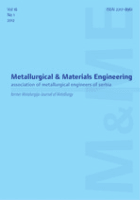
Metallurgical & Materials Engineering
Scope & Guideline
Bridging theory and application in materials science.
Introduction
Aims and Scopes
- Metallurgical Processes and Innovations:
Research on various metallurgical processes including but not limited to welding, casting, and coating techniques, along with innovative methods for enhancing material properties. - Material Characterization and Properties:
Focus on the characterization of materials, investigating their mechanical, thermal, and corrosion properties, and understanding how these properties can be tailored for specific applications. - Application of Advanced Materials:
Exploration of advanced materials such as composites, alloys, and nanomaterials, including their applications in sectors like automotive, aerospace, and construction. - Sustainability and Recycling Techniques:
Research initiatives aimed at promoting sustainability in materials engineering, including recycling processes and the development of eco-friendly materials. - Computational and Predictive Modeling:
Utilization of computational tools and predictive modeling techniques to understand material behaviors, optimize processes, and forecast performance under various conditions.
Trending and Emerging
- Smart Materials and Actuators:
An increasing number of studies are focusing on the development and application of smart materials, particularly those utilizing shape memory alloys for innovative applications in engineering and technology. - Sustainable Materials and Processes:
There is a noticeable trend towards researching sustainable materials and processes, including the recycling of materials and the development of eco-friendly composites, driven by global sustainability goals. - Advanced Characterization Techniques:
Emerging methodologies for material characterization, particularly those employing nanotechnology and advanced imaging techniques, are becoming a focal point for researchers aiming to better understand material properties. - Artificial Intelligence and Predictive Analytics:
The integration of AI and machine learning in materials research is on the rise, with studies focusing on predictive modeling to enhance material development and performance evaluation. - Multifunctional Composite Materials:
Research into multifunctional composites that provide multiple beneficial properties, such as enhanced strength and thermal resistance, is gaining momentum, reflecting the need for innovative materials in various applications.
Declining or Waning
- Traditional Metallurgical Techniques:
There appears to be a waning focus on conventional metallurgical processes that do not incorporate modern advancements or innovations, as the field shifts towards more cutting-edge techniques. - Purely Theoretical Studies:
Research that lacks empirical validation or practical application is becoming less prominent, as the journal emphasizes studies that combine theory with experimental evidence. - Static Material Studies:
Investigations that only assess materials under static conditions without considering dynamic or real-world applications are declining, as there is a growing demand for studies that reflect actual service conditions.
Similar Journals

Journal of Metals Materials and Minerals
Pioneering Research in Metallurgical Science and EngineeringJournal of Metals Materials and Minerals (ISSN: 0857-6149) is a renowned academic publication dedicated to the interdisciplinary fields of metallurgical science, materials engineering, and mineralogy. Published by Chulalongkorn University, Metallurgy & Materials Science Research Institute in Thailand, this journal serves as a pivotal platform for researchers to disseminate their findings and explore innovative applications related to metals, ceramics, polymers, and biomaterials. Although the journal does not currently adopt an open-access model, it provides insightful content that facilitates knowledge sharing among professionals and academics alike. The journal has established its credibility with impressive Scopus ranking percentiles, particularly in categories such as Metals and Alloys and Ceramics and Composites. With an emphasis on advancing the understanding of materials science from 2017 to 2024, the Journal of Metals Materials and Minerals remains an essential resource for those striving to contribute to and stay informed about the latest trends and breakthroughs in these dynamic fields.

METALLURGIA ITALIANA
Pioneering Insights in the Mechanics of MaterialsMETALLURGIA ITALIANA, an esteemed journal published by the ASSOCIAZIONE ITALIANA METALLURGIA, specializes in the fields of condensed matter physics, mechanics of materials, and metals and alloys. With a history spanning from 1969 to 2024, this Italian journal has consistently contributed to the scholarly conversation surrounding metallurgical sciences and materials engineering. Despite its Q4 ranking in several categories, the journal provides a critical platform for emerging research and advancements in metallurgy, encouraging interdisciplinary dialogue among academics, professionals, and students. Readers can benefit from valuable insights into the latest developments and applications in the field, supported by the journal's commitment to fostering academic rigor and innovation. While access options currently do not include open access, METALLURGIA ITALIANA remains a cherished resource for those dedicated to exploring the nuances of material properties and applications.

METALURGIJA
Connecting researchers to shape the future of metallurgy.METALURGIJA is a distinguished open-access journal published by the Croatian Metallurgical Society, dedicated to advancing the field of metallurgical sciences and engineering. With an ISSN of 0543-5846 and E-ISSN of 1334-2576, this journal has been serving the academic community since its inception, offering valuable insights into condensed matter physics, materials chemistry, mechanics of materials, and metals and alloys. As of 2023, it ranks in Q3 in the fields of condensed matter physics, materials chemistry, and mechanics of materials, and Q2 in metals and alloys, reflecting its engagement with contemporary research and emerging trends. The journal's open-access policy, in place since 2002, ensures that high-quality research is accessible to a global audience, fostering collaboration and knowledge sharing. Located in Zagreb, Croatia, METALURGIJA aims to bring together researchers, industry professionals, and students alike to contribute to systemic advancements in metallurgical research and applications, ultimately enhancing innovation within the materials science community.
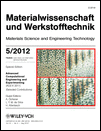
MATERIALWISSENSCHAFT UND WERKSTOFFTECHNIK
Bridging Theory and Application in Materials Technology.MATERIALWISSENSCHAFT UND WERKSTOFFTECHNIK, published by WILEY-V C H VERLAG GMBH, is a prominent journal dedicated to the field of materials science and engineering. With its ISSN 0933-5137 and E-ISSN 1521-4052, this journal serves as a vital resource for researchers and professionals engaged in exploring the intricate relationships between the properties of materials and their applications. Established in 1970 and continuing through 2024, the journal has been consistently recognized in various categories, achieving a Q3 ranking in 2023 across Condensed Matter Physics, Materials Science (miscellaneous), Mechanical Engineering, and Mechanics of Materials. Although it does not offer open access, its high-quality peer-reviewed content is fundamental to the advancement of knowledge within its three key areas: novel material development, material characterization, and application of materials in engineering contexts. As a driving force in the scientific community, MATERIALWISSENSCHAFT UND WERKSTOFFTECHNIK continues to cater to the curiosity of aspiring students, seasoned professionals, and researchers alike, facilitating a deeper understanding of the complexities of material technology.

Russian Journal of Non-Ferrous Metals
Shaping the Future of Materials ScienceThe Russian Journal of Non-Ferrous Metals, published by PLEIADES PUBLISHING INC, serves as a vital resource for researchers and professionals in the fields of materials science and engineering. With a dual ISSN (1067-8212 for print and 1934-970X for online), this journal has been instrumental in disseminating cutting-edge research from 2007 to 2023. Specializing in the mechanics of materials, metals and alloys, and the study of surfaces, coatings, and films, it provides invaluable insights into the latest advancements and applications in these areas. Although currently categorized in the Q4 tier for mechanics of materials and surfaces, and Q3 for metals and alloys in the 2023 rankings, its commitment to quality research is reflected in its Scopus metrics, ranking it within the competitive spectrum of its fields. While not an open access journal, it remains a crucial academic platform for fostering knowledge exchange among professionals and scholars. By publishing high-quality articles, the Russian Journal of Non-Ferrous Metals contributes significantly to the ongoing dialogue in metallurgical science and engineering.
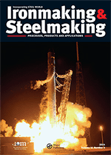
IRONMAKING & STEELMAKING
Shaping Tomorrow’s Steel: A Journal of InnovationIRONMAKING & STEELMAKING is a premier peer-reviewed journal published by SAGE Publications Inc, dedicated to advancing the field of metallurgical engineering and materials science. With a notable ISSN of 0301-9233 and an E-ISSN of 1743-2812, this journal has established itself as a significant platform for disseminating high-quality research on ironmaking processes, steel production, and associated technologies. Covering a broad scope of topics, it is indexed in the top quartiles (Q2) in Materials Chemistry, Mechanical Engineering, Mechanics of Materials, and Metals and Alloys for 2023, underscoring its pivotal role in these disciplines. Since its inception in 1974 and continuing through 2024, IRONMAKING & STEELMAKING attracts a global audience of researchers, professionals, and students, contributing valuable insights and innovations in the field. Although not an open-access publication, subscribers can access essential findings that shape the future of metallurgy and steelmaking. This journal not only serves as a repository of knowledge but also as a beacon for ongoing research and technological advancement, making it a must-read for those passionate about materials science.
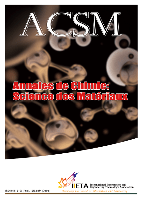
ANNALES DE CHIMIE-SCIENCE DES MATERIAUX
Fostering Insightful Dialogues in Material ScienceANNALES DE CHIMIE-SCIENCE DES MATERIAUX, published by the International Information & Engineering Technology Association, serves as a significant resource in the field of materials chemistry. With an ISSN of 0151-9107 and an E-ISSN of 1958-5934, this journal has been contributing to the scientific discourse since its inception in 1947. The journal is classified in the Q3 category for Materials Chemistry in 2023, positioning it within the 29th percentile in the Scopus ranking for materials science, underscoring its commitment to advancing knowledge and innovation in this vital area of research. Although currently not an open access publication, the journal welcomes submissions that explore a broad range of topics related to material science, thereby facilitating discussions that can lead to groundbreaking discoveries. Researchers, professionals, and students are encouraged to engage with the journal to stay at the forefront of materials chemistry, especially given its historical context and ongoing relevance in academic and industrial applications.
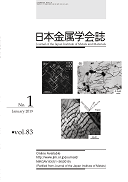
Journal of the Japan Institute of Metals and Materials
Advancing metallurgy and materials science since 1937.Journal of the Japan Institute of Metals and Materials (ISSN: 0021-4876, E-ISSN: 1880-6880) serves as a vital academic platform under the esteemed auspices of the Japan Institute of Metals & Materials. This journal, with a rich publication history dating back to 1937, focuses on advancing knowledge in the fields of metallurgy, materials science, and engineering, making it an important resource for researchers, professionals, and students alike. Although the journal has been categorized in Q4 quartiles across several subject areas, including Condensed Matter Physics and Materials Chemistry, it plays a critical role in disseminating essential findings and fostering discussion regarding innovations in metal and materials research. Notably, the journal operates without open access, which encourages targeted readership engagement through its curated content. Based in Japan, it continues to contribute significantly to the academic community by bridging the gap between scientific inquiry and practical application in materials technology.

METALLURGICAL AND MATERIALS TRANSACTIONS B-PROCESS METALLURGY AND MATERIALS PROCESSING SCIENCE
Advancing the Frontiers of Metallurgy and Materials ProcessingMETALLURGICAL AND MATERIALS TRANSACTIONS B-PROCESS METALLURGY AND MATERIALS PROCESSING SCIENCE, published by Springer, serves as a pivotal platform in advancing the field of materials science, focusing specifically on the intricacies of process metallurgy and materials processing. With an ISSN of 1073-5615 and an E-ISSN of 1543-1916, this esteemed journal boasts an impressive standing with its 2023 category quartiles, ranking Q2 in Condensed Matter Physics, Materials Chemistry, and Mechanics of Materials, while achieving a top-tier Q1 classification in Metals and Alloys. Positioned in the United States, the journal has been publishing leading research since its inception, with converged years spanning from 1973 to 1979 and 1995 to 2024. The journal's robust impact within its fields is reflected in its Scopus rankings, notably ranking #42 out of 176 in Materials Science with a 76th percentile. Though not an open access journal, its comprehensive and high-quality research articles cater to the needs of researchers, professionals, and students, ensuring they remain at the forefront of advancements in metallurgy and materials processing science.

INTERNATIONAL JOURNAL OF CAST METALS RESEARCH
Exploring Innovations in Mechanical Engineering and Materials ScienceInternational Journal of Cast Metals Research, published by Taylor & Francis Ltd, serves as a premier platform for the dissemination of cutting-edge research in the fields of Mechanical Engineering, Mechanics of Materials, and Metals and Alloys. With a commitment to advancing the understanding of cast metals, this peer-reviewed journal has achieved notable recognition, featuring a 2023 Q2 ranking in its respective categories and ranking 71st in the Materials Science field according to Scopus. Researchers and professionals will find a wealth of valuable insights through rigorous studies and innovative findings, reflecting the journal's goal of facilitating knowledge transfer and addressing contemporary challenges in material science. Furthermore, its accessible publication years from 1996 to 2024 ensure that it not only captures the evolution of technology in cast metals but also stands at the forefront of future developments. Ideal for academics and practitioners alike, the journal aims to foster collaboration and inspire new developments within the discipline.